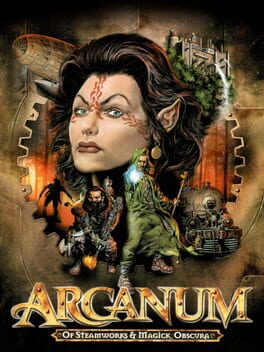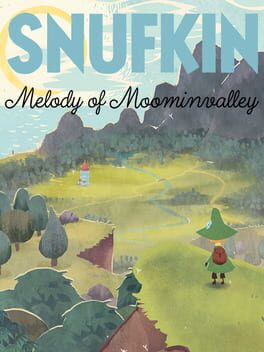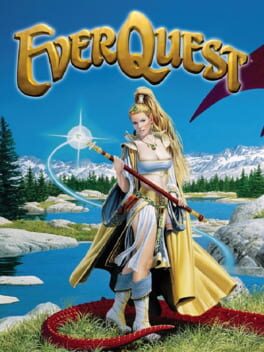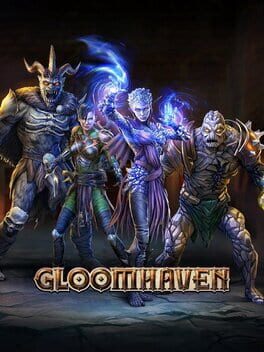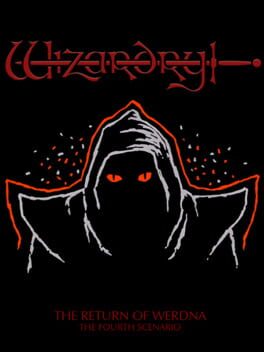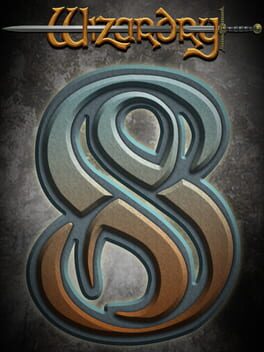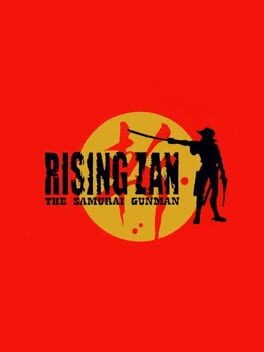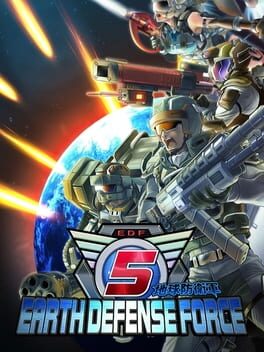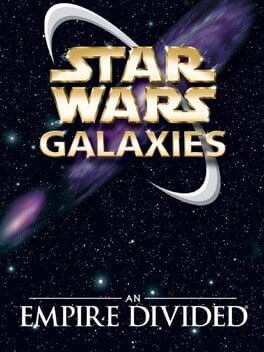Evolknaj
17 reviews liked by Evolknaj
When I think of video game soundtracks that perfectly exemplify a games' atmosphere and resonance, Arcanum: of Steamworks and Magick Obscura is the first one that comes to mind. This is such a special piece of art that has had a bit of a resurgence in recent years due to it's rich worldbuilding and genuinely fantastic writing (despite the horrifically janky combat and bugs). While all the praise for Arcanum is well deserved and known, I feel as the soundtrack gets overlooked and mentioned mostly as unique but repetitive. However, I feel Ben Houge has composed one of the best pieces of VGM that has perfectly capture the essence of Arcanum
EverQuest
1999
Back in like year 2000, I had to play the demo because my dad did not want me to play online (I was 11).
Dad drowned in the Halas water. It was literally pitch black screen underwater so he got desperate and had me locate his body at the bottom. Can't remember how long it took to find, but after that I was allowed to play.
Just the right balance of exploration and progression without holding your hand. Not a theme park MMO trying to boost you to max level as soon as possible.
Admittedly, without nostalgia for it the combat speed may be too big of a barrier to overcome.
Still playing on and off on different progression servers to this day!
Dad drowned in the Halas water. It was literally pitch black screen underwater so he got desperate and had me locate his body at the bottom. Can't remember how long it took to find, but after that I was allowed to play.
Just the right balance of exploration and progression without holding your hand. Not a theme park MMO trying to boost you to max level as soon as possible.
Admittedly, without nostalgia for it the combat speed may be too big of a barrier to overcome.
Still playing on and off on different progression servers to this day!
Gloomhaven
2019
(Replay)
Still such a great digital implementation of my favorite boardgame. As great as the original boardgame is, parts of its systems are time-consuming to keep up with manually and felt like they wanted to be a videogame, and turns out they’re great as a videogame that wants to be a boardgame. My party this time was Berserker, Sunkeeper, and Soothsinger. They worked together remarkably well and I had a great time running them through several mid-campaign missions until retirement. I’m putting this down again for a few months to play other stuff, but I already can’t wait to pick back up then with a Nightshroud and Quartermaster.
The real question is when Frosthaven’s adaptation is coming out. :)
Still such a great digital implementation of my favorite boardgame. As great as the original boardgame is, parts of its systems are time-consuming to keep up with manually and felt like they wanted to be a videogame, and turns out they’re great as a videogame that wants to be a boardgame. My party this time was Berserker, Sunkeeper, and Soothsinger. They worked together remarkably well and I had a great time running them through several mid-campaign missions until retirement. I’m putting this down again for a few months to play other stuff, but I already can’t wait to pick back up then with a Nightshroud and Quartermaster.
The real question is when Frosthaven’s adaptation is coming out. :)
Amidst the bubbling pot of sadistic devotion, Wizardry 4 is really one of gaming’s great contrarian statements. A chance to thwart the heroes in an underdog story — the quest upwards for spiritual salvation. Running counter to conventional game wisdom, the Gygaxian langauge is dealt in dissonant logic and prudent play, forcing the player to rethink their approach to dungeon crawling. Without skill check, the labyrinth becomes all the more treacherous, where life or death rests entirely within our pool of knowledge.
Sure. It’s hell. But it’s calculated hell; cunning in all the right ways; wildly eccentric when it sees fit. Supported by its transformative scenario design, there was nothing else this unusual. Roe R Adams had assisted Ultima 4 on a spiritual revolution, defining RPGs as more than mere numbers and combat, using the journey as a basis for moral exploration. The result of his work on Wizardry 4 was the audacious inversion of roles, with not only narrative implication but fundamental change to design. We are ascending; we occupy the top row of the battle screen while the “heroes”' are on the bottom (like every other RPG); we fight with hordes of summoned monsters; and we have a choice of salvation or continued chaos on the surface. How rare was it to have a massive, pre-defined set of party members to choose from, let alone your foes who drove you mad in the first three scenarios. The kicker? If you sent your characters from the original scenarios to Sir-Tech, they would appear as wandering enemies for Werdna to fight. Yes, your battles are against the real adventuring parties of past players.
There are five, wholly unique endings in this game, going beyond the traditional dichotomy of good or evil. All of this is running on the stock 64KB Apple II. These were the days when a bevy of sequels to established franchises were showing up and developers were truly eager to break new ground. Wizardry 4’s mission is clear, in that it's firmly designed for experienced players, but has an imbued sense of moral-purpose backing its foundation. The expression is defined through the challenge of genre convention — and there was perhaps no one more qualified for the task than Werdna, the first iconic RPG villain, who would smite you down without fail in the original game.
(Note: I won’t cover in depth that this was the first game to feature a monster party, a highly original (and controversial) concept for its development time. Megami Tensei did come out the same year, nor do I particularly care for firsts, and prefer to think of game design as a conceptual pool that many draw from).
Much like Wizardry 1, the main enemy of the game is the labyrinthine dungeon, fervently zapping away at your resources. Instead of plunging into the darkness and returning to town for purified air, we must navigate our god-given morbid imprisonment as a means of respite. Said respite is found through the pentagram system (think of these as safe-rooms), but you are either being flanked by hero groups or the mad king, who never ceases chase, moving in real-time (even during idle) and will kill you instantly if found. Can you make it to the next safe-room? The clock is always ticking. The dynamic is that the hero groups will play by your traditional map rules, but the mad king can usurp you at any time, forgoing the board entirely. Staying idle is not an option; it’s a game of continuous movement and tense decision making. We hang on to every last spell. Summoned monsters are your weaponry, but they drop like flies and are prone to fleeing at the hint of resistance. Wandering hero groups fight you as if it’s their last battle. In their world; we are the final boss; and are accordingly shown no remorse. These enemy-types stay permanently dead until you save. Saving resets the mad king's position completely, making him non-threatening. (I will mention to be clear, you can save anywhere in this game, any square, safe or not. And you have enough time to explore, but just enough “push” that it’s imperative to stay moving). Which reprieve will you choose?
This well-crafted risk/reward dilemma places players in a constant state of tension, weighing the need for exploration (further knowledge), the quest for vital resources (spells and items), and the imperative for acute survival — by either rendering enemies dead (don’t save) or ending the mad king’s relentless pursuit (choose to save). This follows the design idea of a tactical-puzzle, in which each floor become a devout ritual of manic exploration and planned resources, in a lead to find the next safe-room. The pentagram is safe from all hostile forces and doubles as a utility hub for resources, such as a rotating cast of monsters and leveling up. Monsters act as the pragmatic puzzle pieces that fit the design as one. Finding out how they work for the situation at hand is paramount to survival, and knowledge of the previous three scenarios is rather valuable, if not essential. Like an enigma being constantly unraveled, the game sees fit to evolve, with monsters and riddles being in constant flux, changing every pentagram. The goal is to fully regain your powers, and believe me, there is no greater satisfaction than when you can finally teleport throughout the entire dungeon and blast the hero scum to smithereens with great demons at your side. The last barrier standing between you and freedom is the Cosmic Cube. If every previous floor has been a delicate challenge of abstract mapping concepts, this is the test that questions how attentive you’ve really been, by bringing all learned principles to the forefront and merging three floors into a quasi-connected "3D" level. (For anyone unfamiliar: Picture a simple 20x20 square grid. A 3D dungeon adds a third coordinate into the mix, meaning you get 20x20x3 and account for a multi-layered map that functions as one with ladders and teleports. A number of paths can reach the exit — making it a highly unique and non-linear puzzle).
By the end, the dungeon presents itself as a large-scale puzzle to solve, and you are able to find an item that sends the mad king to the permanent void, taking him out of the equation entirely. The game does all of this with a clear sense of intention. Playable inferno sure, but a truly bewitching uniqueness that few games can replicate.
Sweet Home rings closest to the design, in that it may have the outer layer of an RPG, but discerning the maze-like structure is more vital than any amount of leveling. Strategic planning is a requirement, with power being incrementally given through the pentagram system and items that play as a finite resource. Grinding is not possible (it is in Sweet Home to be fair, but caps early, and battles are risky, if you die that character is gone for good), so the design is deliberate, to be mapped and solved. Brute forcing your way through the game is far-fetched notion. Our understanding of these games is rather similar. They end up being known for only one thing (decomposing as banal trivia), instead of being assessed on their own terms, as a tense fusion of adventure and RPG design. It may be better described as a true survival RPG — and the game imparts this all too well with layered hostility that never quite settles.
There is an unfounded notion that Wizardry 4 is the hardest game ever made, brutally unfair, as if it can only be one thing. This serves to only strip away the creative authorship of the designer, in which we choose to solely engage with a loaded-definition. At that point, are we actively engaging with the design, or a vague notion of what we think the work should be? (Yes, you’ve seen this before, for a game or any artistic medium). Look. Wizardry 4 is a difficult game. But it isn’t the hardest game ever made; or even atypical of its era, that forged a path on a particular quality of play. The right to win was to be earned — not merely given away as an unequal transaction. Death was a rite of passage that tied together the designer’s ability to communicate game structure and understanding. This isn’t to downplay the challenge, but illustrate that it comes from a place of purposeful intent. The game in actuality is supremely balanced, juggling mechanical complexity on a floor-by-floor basis, and fair for a keen player who is willing to parse it’s deep-rooted design langauge. (That said, the thieves that constantly steal your key-items and run are extremely annoying. This I would have minimized, the only thing in the game I would outright change).
The myth of the first room is quite frankly, bullshit. For reference, you begin the game in a 2x2 dark room with a lone pentagram at your side and a hidden door on the wall. Now, think how unconventional the monster system was, how this room provides a completely safe environment, and teaches us about a secret-heavy game. Even more, the game relies on monster usage relating to the floor at hand, which is also taught here. By getting out of here: We know about secrets, we’ve understood how monsters function in a safe environment, and we’ve learned the importance of pentagrams. This is silent game design, routine for the time, and a rather good bout at that. But you need a priest, right?. Oh dear. Werdna is completely powerless. He is a sitting duck in the bowels of hell. Anyone who has played an RPG for 30 minutes knows that you need a healer on your team. This simple puzzle now ties logic into its teaching exercise and sets the tone for the game accordingly. Right away, we are given the baseline understanding to succeed – all with zero risk of death. Metroid and Dragon Quest 1 both start in a similar manner with a resistant-problem (morph ball and command system, respectively). Presenting friction to the player that allows them to learn the langauge. Funny enough, a sealed envelope was included with the game dubbed “solution to the first puzzle” that mocked anyone who couldn’t get past it and told them to give up, because the real challenge was coming. The most beautiful words an 80’s nerd can hear.
Sir-Tech succeeded tremendously well at the inversion of what a dungeon crawler could be: Taking skill check out of the equation with a dynamic risk/reward scheme and relying on expert-level logic as its preeminent philosophy. The inventive scenario design only served to further the goal, running contrary to all RPGs. It stands alone as this high-concept performance piece — made by the inmates for the asylum — read in silence as a maddening love letter to our earliest roots of gaming. In that sense, Wizardry 4 marks the end of the PLATO lineage. A long lost embodiment of what one culture thought interactive software should be. They don’t make em’ like this anymore. Even attempting so would be futile.
Criminally misunderstood is my verdict. One that paints a stark contrast of ideas; out of the dungeon and into the light. A question of faith that must be earned, through the form of perilous redemption under deafening opposition. It took me over half a year to finish, toiling away at its secrets. At the end of it all, it really does feel like you have climbed the darkest mountain to salvation. I respect the hell out of this game. Video games do not dare to go here again.
Sure. It’s hell. But it’s calculated hell; cunning in all the right ways; wildly eccentric when it sees fit. Supported by its transformative scenario design, there was nothing else this unusual. Roe R Adams had assisted Ultima 4 on a spiritual revolution, defining RPGs as more than mere numbers and combat, using the journey as a basis for moral exploration. The result of his work on Wizardry 4 was the audacious inversion of roles, with not only narrative implication but fundamental change to design. We are ascending; we occupy the top row of the battle screen while the “heroes”' are on the bottom (like every other RPG); we fight with hordes of summoned monsters; and we have a choice of salvation or continued chaos on the surface. How rare was it to have a massive, pre-defined set of party members to choose from, let alone your foes who drove you mad in the first three scenarios. The kicker? If you sent your characters from the original scenarios to Sir-Tech, they would appear as wandering enemies for Werdna to fight. Yes, your battles are against the real adventuring parties of past players.
There are five, wholly unique endings in this game, going beyond the traditional dichotomy of good or evil. All of this is running on the stock 64KB Apple II. These were the days when a bevy of sequels to established franchises were showing up and developers were truly eager to break new ground. Wizardry 4’s mission is clear, in that it's firmly designed for experienced players, but has an imbued sense of moral-purpose backing its foundation. The expression is defined through the challenge of genre convention — and there was perhaps no one more qualified for the task than Werdna, the first iconic RPG villain, who would smite you down without fail in the original game.
(Note: I won’t cover in depth that this was the first game to feature a monster party, a highly original (and controversial) concept for its development time. Megami Tensei did come out the same year, nor do I particularly care for firsts, and prefer to think of game design as a conceptual pool that many draw from).
Much like Wizardry 1, the main enemy of the game is the labyrinthine dungeon, fervently zapping away at your resources. Instead of plunging into the darkness and returning to town for purified air, we must navigate our god-given morbid imprisonment as a means of respite. Said respite is found through the pentagram system (think of these as safe-rooms), but you are either being flanked by hero groups or the mad king, who never ceases chase, moving in real-time (even during idle) and will kill you instantly if found. Can you make it to the next safe-room? The clock is always ticking. The dynamic is that the hero groups will play by your traditional map rules, but the mad king can usurp you at any time, forgoing the board entirely. Staying idle is not an option; it’s a game of continuous movement and tense decision making. We hang on to every last spell. Summoned monsters are your weaponry, but they drop like flies and are prone to fleeing at the hint of resistance. Wandering hero groups fight you as if it’s their last battle. In their world; we are the final boss; and are accordingly shown no remorse. These enemy-types stay permanently dead until you save. Saving resets the mad king's position completely, making him non-threatening. (I will mention to be clear, you can save anywhere in this game, any square, safe or not. And you have enough time to explore, but just enough “push” that it’s imperative to stay moving). Which reprieve will you choose?
This well-crafted risk/reward dilemma places players in a constant state of tension, weighing the need for exploration (further knowledge), the quest for vital resources (spells and items), and the imperative for acute survival — by either rendering enemies dead (don’t save) or ending the mad king’s relentless pursuit (choose to save). This follows the design idea of a tactical-puzzle, in which each floor become a devout ritual of manic exploration and planned resources, in a lead to find the next safe-room. The pentagram is safe from all hostile forces and doubles as a utility hub for resources, such as a rotating cast of monsters and leveling up. Monsters act as the pragmatic puzzle pieces that fit the design as one. Finding out how they work for the situation at hand is paramount to survival, and knowledge of the previous three scenarios is rather valuable, if not essential. Like an enigma being constantly unraveled, the game sees fit to evolve, with monsters and riddles being in constant flux, changing every pentagram. The goal is to fully regain your powers, and believe me, there is no greater satisfaction than when you can finally teleport throughout the entire dungeon and blast the hero scum to smithereens with great demons at your side. The last barrier standing between you and freedom is the Cosmic Cube. If every previous floor has been a delicate challenge of abstract mapping concepts, this is the test that questions how attentive you’ve really been, by bringing all learned principles to the forefront and merging three floors into a quasi-connected "3D" level. (For anyone unfamiliar: Picture a simple 20x20 square grid. A 3D dungeon adds a third coordinate into the mix, meaning you get 20x20x3 and account for a multi-layered map that functions as one with ladders and teleports. A number of paths can reach the exit — making it a highly unique and non-linear puzzle).
By the end, the dungeon presents itself as a large-scale puzzle to solve, and you are able to find an item that sends the mad king to the permanent void, taking him out of the equation entirely. The game does all of this with a clear sense of intention. Playable inferno sure, but a truly bewitching uniqueness that few games can replicate.
Sweet Home rings closest to the design, in that it may have the outer layer of an RPG, but discerning the maze-like structure is more vital than any amount of leveling. Strategic planning is a requirement, with power being incrementally given through the pentagram system and items that play as a finite resource. Grinding is not possible (it is in Sweet Home to be fair, but caps early, and battles are risky, if you die that character is gone for good), so the design is deliberate, to be mapped and solved. Brute forcing your way through the game is far-fetched notion. Our understanding of these games is rather similar. They end up being known for only one thing (decomposing as banal trivia), instead of being assessed on their own terms, as a tense fusion of adventure and RPG design. It may be better described as a true survival RPG — and the game imparts this all too well with layered hostility that never quite settles.
There is an unfounded notion that Wizardry 4 is the hardest game ever made, brutally unfair, as if it can only be one thing. This serves to only strip away the creative authorship of the designer, in which we choose to solely engage with a loaded-definition. At that point, are we actively engaging with the design, or a vague notion of what we think the work should be? (Yes, you’ve seen this before, for a game or any artistic medium). Look. Wizardry 4 is a difficult game. But it isn’t the hardest game ever made; or even atypical of its era, that forged a path on a particular quality of play. The right to win was to be earned — not merely given away as an unequal transaction. Death was a rite of passage that tied together the designer’s ability to communicate game structure and understanding. This isn’t to downplay the challenge, but illustrate that it comes from a place of purposeful intent. The game in actuality is supremely balanced, juggling mechanical complexity on a floor-by-floor basis, and fair for a keen player who is willing to parse it’s deep-rooted design langauge. (That said, the thieves that constantly steal your key-items and run are extremely annoying. This I would have minimized, the only thing in the game I would outright change).
The myth of the first room is quite frankly, bullshit. For reference, you begin the game in a 2x2 dark room with a lone pentagram at your side and a hidden door on the wall. Now, think how unconventional the monster system was, how this room provides a completely safe environment, and teaches us about a secret-heavy game. Even more, the game relies on monster usage relating to the floor at hand, which is also taught here. By getting out of here: We know about secrets, we’ve understood how monsters function in a safe environment, and we’ve learned the importance of pentagrams. This is silent game design, routine for the time, and a rather good bout at that. But you need a priest, right?. Oh dear. Werdna is completely powerless. He is a sitting duck in the bowels of hell. Anyone who has played an RPG for 30 minutes knows that you need a healer on your team. This simple puzzle now ties logic into its teaching exercise and sets the tone for the game accordingly. Right away, we are given the baseline understanding to succeed – all with zero risk of death. Metroid and Dragon Quest 1 both start in a similar manner with a resistant-problem (morph ball and command system, respectively). Presenting friction to the player that allows them to learn the langauge. Funny enough, a sealed envelope was included with the game dubbed “solution to the first puzzle” that mocked anyone who couldn’t get past it and told them to give up, because the real challenge was coming. The most beautiful words an 80’s nerd can hear.
Sir-Tech succeeded tremendously well at the inversion of what a dungeon crawler could be: Taking skill check out of the equation with a dynamic risk/reward scheme and relying on expert-level logic as its preeminent philosophy. The inventive scenario design only served to further the goal, running contrary to all RPGs. It stands alone as this high-concept performance piece — made by the inmates for the asylum — read in silence as a maddening love letter to our earliest roots of gaming. In that sense, Wizardry 4 marks the end of the PLATO lineage. A long lost embodiment of what one culture thought interactive software should be. They don’t make em’ like this anymore. Even attempting so would be futile.
Criminally misunderstood is my verdict. One that paints a stark contrast of ideas; out of the dungeon and into the light. A question of faith that must be earned, through the form of perilous redemption under deafening opposition. It took me over half a year to finish, toiling away at its secrets. At the end of it all, it really does feel like you have climbed the darkest mountain to salvation. I respect the hell out of this game. Video games do not dare to go here again.
An incredible achievement for an early Gameboy title, "Suffering of the Queen" translates Wizardry V gameplay to the small screen with the first of a series of original titles. Still for the most hardcore of the hardcore, the presence of multiple endings, secret bosses, and seemingly endless powerful loot must have made this a huge battery suck for Japanese children in the early 90's.
A must play for those who have already exhausted all the classic American Wizardry titles.
A must play for those who have already exhausted all the classic American Wizardry titles.
Wizardry 8
2001
Picture this - A wisecracking, too cool for school action game hero who wields sword and gun in accord, has access to a variety of special moves and the ability to expend a meter to temporarily power himself up, and runs through a bunch of linear levels, being graded with a rating at the end of each of them. Sounds familiar, right? If it's not Devil May Cry, it's one of the many games strongly inspired by it that populated the PS2 era (and the PS3's to a lesser degree). Rising Zan seems to fit this concept, until you glance at the release date and realize it's a PS1 game that came out roughly two years before DMC1.
Don't get me wrong, I'm not trying to accuse Capcom of plagiarism or whatever, DMC is pretty distinct from this game, which is small enough that I wouldn't be surprised if they never even knew of it, it's just that playing Rising Zan feels like finding a pistol inside an Egyptian pyramid. It's fascinating, honestly, this is a game with many aspects of the Hack 'N Slash genre that wouldn't be codified until much later.
Let's get back to Rising Zan, though. It starts with... quite frankly one of the best intros I've ever seen. Sets the tone perfectly, it's somehow really cheesy but kinda raw at the same time, it's one nasty earworm, honestly all games should start like that. Not being able to understand the lyrics kinda takes away from the charm, but I'd say the JP intro is also quite good. Rising Zan is a stylish game - it never misses an opportunity to show off the protagonist's incredible strength with big ol' QTEs, and at the end of every fight you get to pull off a finisher on the chapter's boss as the theme song plays. Great stuff on that front.
How does it play though? Well, the base combat is actually fairly alright. You've got your fighting game command input attacks, your super mode that's a bit wacky to control because it literally makes Zan move at x2 speed, and your gun and sword attacks, including a combo where you use both. It's nothing too complex, but it feels good enough to do, especially the special moves. Rising Zan is a short game and that's probably for the better; there isn't any way to upgrade yourself or get new moves, it's just a straight shot to the end. Where Zan begins to fall apart is in the actual levels. There isn't any bit that's incredibly horrible but a whole lot of tiny issues that make the experience fall flat a bit. The aforementioned QTEs get pretty demanding by the end, and they're all just mashing for a long span of time, which gets tiring. You don't die if you fail them but you do take unavoidable damage, which is rough because this is not exactly an easy game, levels are long and if you lose you gotta do them over again. I sidestepped that issue with save states but it'd be really annoying if I couldn't.
Another issue is the camera control, or lack thereof. You turn around and it kinda turns with you. You hold L1 and it sometimes moves behind your back. It's mostly fine at the beginning, but as enemies get more mobile, it's not uncommon to struggle to actually face one or even see all attacks coming, especially when getting hit sends you flying and resets your camera (Pro tip, you can see enemies and projectiles in the mini-map at all times). Some enemies just suck, too, and the game sorta feels like it's trying to have a bit more story than it does.
Anyways, Rising Zan also has a second playable character, unlocked when you beat the game (I played her a bit and she didn't seem too different, but I don't think I found all her moves), and a bonus mode you can unlock to put both characters in their underwear (Zan keeps the hat, of course). Y'know, I'm not the guy to get turned on by a PS1 model but I do respect the equality, most games would have only put the lady in the fanservice costume.
I'd have liked to see a sequel, but the company behind Rising Zan disbanded not even 2 years after, so clearly it passed under the radar. Bit of a shame, there's more than a hint of BS in places, for sure, but I don't think it's awful, just unrefined, there's fun to be had.
Don't get me wrong, I'm not trying to accuse Capcom of plagiarism or whatever, DMC is pretty distinct from this game, which is small enough that I wouldn't be surprised if they never even knew of it, it's just that playing Rising Zan feels like finding a pistol inside an Egyptian pyramid. It's fascinating, honestly, this is a game with many aspects of the Hack 'N Slash genre that wouldn't be codified until much later.
Let's get back to Rising Zan, though. It starts with... quite frankly one of the best intros I've ever seen. Sets the tone perfectly, it's somehow really cheesy but kinda raw at the same time, it's one nasty earworm, honestly all games should start like that. Not being able to understand the lyrics kinda takes away from the charm, but I'd say the JP intro is also quite good. Rising Zan is a stylish game - it never misses an opportunity to show off the protagonist's incredible strength with big ol' QTEs, and at the end of every fight you get to pull off a finisher on the chapter's boss as the theme song plays. Great stuff on that front.
How does it play though? Well, the base combat is actually fairly alright. You've got your fighting game command input attacks, your super mode that's a bit wacky to control because it literally makes Zan move at x2 speed, and your gun and sword attacks, including a combo where you use both. It's nothing too complex, but it feels good enough to do, especially the special moves. Rising Zan is a short game and that's probably for the better; there isn't any way to upgrade yourself or get new moves, it's just a straight shot to the end. Where Zan begins to fall apart is in the actual levels. There isn't any bit that's incredibly horrible but a whole lot of tiny issues that make the experience fall flat a bit. The aforementioned QTEs get pretty demanding by the end, and they're all just mashing for a long span of time, which gets tiring. You don't die if you fail them but you do take unavoidable damage, which is rough because this is not exactly an easy game, levels are long and if you lose you gotta do them over again. I sidestepped that issue with save states but it'd be really annoying if I couldn't.
Another issue is the camera control, or lack thereof. You turn around and it kinda turns with you. You hold L1 and it sometimes moves behind your back. It's mostly fine at the beginning, but as enemies get more mobile, it's not uncommon to struggle to actually face one or even see all attacks coming, especially when getting hit sends you flying and resets your camera (Pro tip, you can see enemies and projectiles in the mini-map at all times). Some enemies just suck, too, and the game sorta feels like it's trying to have a bit more story than it does.
Anyways, Rising Zan also has a second playable character, unlocked when you beat the game (I played her a bit and she didn't seem too different, but I don't think I found all her moves), and a bonus mode you can unlock to put both characters in their underwear (Zan keeps the hat, of course). Y'know, I'm not the guy to get turned on by a PS1 model but I do respect the equality, most games would have only put the lady in the fanservice costume.
I'd have liked to see a sequel, but the company behind Rising Zan disbanded not even 2 years after, so clearly it passed under the radar. Bit of a shame, there's more than a hint of BS in places, for sure, but I don't think it's awful, just unrefined, there's fun to be had.
O, we are the valiant infantry!
We are the alpha team with passion and comraderie!
Hear as we shout at the top of our lungs,
"Be calm, be bold, and raise your guns!"
High up in the air our comrades fight,
Dashing through the sky now like a million bolts of light.
We shall spread our wings wide and fly high,
Soaring, gliding through the endless sky!
It is only with our sacrifice
That mankind can still exist down here in paradise!
To defend our dearest Mother Earth
We're ready to give up our lives!
Now, pick up our weapons, off we go!
Firing at the flying saucers, shooting down our foes.
We shall not allow these aliens
To rule we Homo Sapiens!
We are the alpha team with passion and comraderie!
Hear as we shout at the top of our lungs,
"Be calm, be bold, and raise your guns!"
High up in the air our comrades fight,
Dashing through the sky now like a million bolts of light.
We shall spread our wings wide and fly high,
Soaring, gliding through the endless sky!
It is only with our sacrifice
That mankind can still exist down here in paradise!
To defend our dearest Mother Earth
We're ready to give up our lives!
Now, pick up our weapons, off we go!
Firing at the flying saucers, shooting down our foes.
We shall not allow these aliens
To rule we Homo Sapiens!
A long time ago in a galaxy far, far away...
Star Wars Galaxies was one of the last glimpses into the old ways of the MMORPG genre, with a year and change in age over World of Warcraft, which would change everything. It wasn't about combat, or levels; early Star Wars Galaxies' combat was not the best, and it did not even have any kind of leveling system. It wasn't about fighting a boss for a chance at a top piece of gear; the best equipment came from a combination of time, money, and experience. It wasn't about long lines of quests, it was about interacting in the living world that moved around you. Star Wars Galaxies was a swansong to MMORPGs that actually embraced the Massive Multiplayer portion of the genre and championed the community over any other aspect of the game.
Your value in the world came from what you actually did, not from a numbered level that tells you how "strong" you are. You could, and many people did, succeed in Star Wars Galaxies without ever engaging in combat. If you wanted to take up dancing in a cantina to grant buffs to other players and socialize with them, you absolutely could, because those who did go out into combat would gladly pay for your skills. Those cantinas could be in any major city across nearly a dozen different planets, some known from Star Wars films and lore, like Mos Eisley, but could also be found in player created cities that also dot those planets. These cities, completely built with player owned homes and commercial buildings that house player owned stores, were unique to each server and housed dozens, maybe hundreds of actual, other players. This was the most redeemable feature of Star Wars Galaxies: a legitimate, breathing community that depended on each other. The players who focused on combat would rely on the players who were dancers or medics for their buffs, or the players who were weaponsmiths to repair or upgrade their blasters. Those weaponsmiths might also depend on players who were dedicated to mining or harvesting the resources needed to build those weapons. There was not much that you could accomplish on your own in Star Wars Galaxies, and the game benefited from that.
Star Wars Galaxies lasted almost nine years, through controversial updates like the Combat Upgrade or the New Game Experience, and well received updates like the Jump to Lightspeed expansion, which added starships and space content. The game's death certificate may as well have been signed on the date that World of Warcraft entered the gaming world, as no old school MMORPG could survive what would become of the genre. As a lifelong Star Wars fan, there has never been any other game that made me feel like I was a part of the Star Wars universe as much as Star Wars Galaxies did, and unfortunately, it seems as if we will never get that type of game again.
Star Wars Galaxies was one of the last glimpses into the old ways of the MMORPG genre, with a year and change in age over World of Warcraft, which would change everything. It wasn't about combat, or levels; early Star Wars Galaxies' combat was not the best, and it did not even have any kind of leveling system. It wasn't about fighting a boss for a chance at a top piece of gear; the best equipment came from a combination of time, money, and experience. It wasn't about long lines of quests, it was about interacting in the living world that moved around you. Star Wars Galaxies was a swansong to MMORPGs that actually embraced the Massive Multiplayer portion of the genre and championed the community over any other aspect of the game.
Your value in the world came from what you actually did, not from a numbered level that tells you how "strong" you are. You could, and many people did, succeed in Star Wars Galaxies without ever engaging in combat. If you wanted to take up dancing in a cantina to grant buffs to other players and socialize with them, you absolutely could, because those who did go out into combat would gladly pay for your skills. Those cantinas could be in any major city across nearly a dozen different planets, some known from Star Wars films and lore, like Mos Eisley, but could also be found in player created cities that also dot those planets. These cities, completely built with player owned homes and commercial buildings that house player owned stores, were unique to each server and housed dozens, maybe hundreds of actual, other players. This was the most redeemable feature of Star Wars Galaxies: a legitimate, breathing community that depended on each other. The players who focused on combat would rely on the players who were dancers or medics for their buffs, or the players who were weaponsmiths to repair or upgrade their blasters. Those weaponsmiths might also depend on players who were dedicated to mining or harvesting the resources needed to build those weapons. There was not much that you could accomplish on your own in Star Wars Galaxies, and the game benefited from that.
Star Wars Galaxies lasted almost nine years, through controversial updates like the Combat Upgrade or the New Game Experience, and well received updates like the Jump to Lightspeed expansion, which added starships and space content. The game's death certificate may as well have been signed on the date that World of Warcraft entered the gaming world, as no old school MMORPG could survive what would become of the genre. As a lifelong Star Wars fan, there has never been any other game that made me feel like I was a part of the Star Wars universe as much as Star Wars Galaxies did, and unfortunately, it seems as if we will never get that type of game again.
